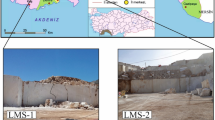Abstract
This study presents detailed description and geochemical characteristics of the efflorescence caused by interaction of water and the concrete on the surface of the seventh granitic stone pagoda in Republic of Korea. The pagoda comprised light gray medium-grained biotite granite with partial porphyritic texture, and it has been repaired for the destroyed parts using concrete in the 1910s. The surface of the pagoda was found to be contaminated by efflorescence at present. As a result of the study, the efflorescence is more concentrated within the areas of water pathway and the northern faces, and in the time of winter season. The efflorescent pollutants were mainly composed of carbonates. Through the extraction experiment, inorganic components of the efflorescence were quantitatively analyzed and discussed for an application with regard to the surface cleaning. The cleaning solvent with pH 6.2 is more effective than pH 5.0 to remove the efflorescent pollutants in general, however, the pH 5.0 solvent showed better results only for anions. Cleaning using chemical agents should be conducted only for small spots with sufficient water washing. And the cleaning effectiveness shows the maximum with the duration of 1 h in which soluble elements dissolve in the solvent the most.







Similar content being viewed by others
References
Boynton WV (1984) Geochemistry of the rare earth elements: meteorite studies. In: Henderson P (ed) Rare earth element geochemistry. Elsevier, Amsterdam, pp 63–107
CHA (Cultural Heritage Administration) (2006) Detailed information of cultural heritages in Korea. http://www.cha.go.kr. Accessed 26 Apr 2008
Fidler J (2002) Stone building, construction and associated component system: their decay and treatment. Engl Herit Res Trans 2:1–114
Jeong YH (1998) Stone pagoda of the Baekje Kingdom. Seoul National University, Seoul, pp 19–29
Lee CH, Choi SW, Suh M (2003) Natural deterioration and conservation treatment for the granite standing Buddha of Daejosa Temple, Republic of Korea. Geotech Eng Geol 21:63–77
Lee CH, Lee MS, Suh M, Choi SW (2005) Weathering and deterioration of rock properties of the Dabotap pagoda (World Cultural Heritage), Republic of Korea. Environ Geol 47:547–557
Lee CH, Lee MS, Kim YT, Kim J (2006) Deterioration assessment and conservation of a heavily degraded Korean stone Buddha from the ninth century. Stud Conserv 51:305–316
Lee CH, Yi JE (2007) Weathering damage evaluation of rock properties in the Bunhwangsa temple stone pagoda, Gyeongju, Republic of Korea. Environ Geol 52:1193–1205
McDonald J, Thomson B, Tonge KH (1992) Chemical cleaning of sandstone comparative laboratory studies. In: Webster RGM (ed) Stone cleaning and the nature, soiling and decay mechanism of stone. Proceeding of the international conference, Edinburgh, London, UK 14–16 Apr 1992, pp 217–226
Nesbitt HW, Young GM (1982) Early proterozoic climates and plate motions inferred from major element chemistry of lutites. Nature 299:715–717
Nesbitt HW, Young GM (1984) Prediction of some weathering trends of plutonic and volcanic rocks based on thermodynamic and kinetic considerations. Geochem Cosmochem Acta 48:1523–1534
Nockolds SR, Allen R (1954) Average chemical compositions of some igneous rocks. Geol Soc Am Bull 65:1007–1032
NRICP (National Research Institute of Cultural Properties) (2003) The purpose and method of the disassembly survey. Report of the stone pagoda in the Mireuksaji temple site I. Report of National Research Institute of Cultural Properties of Korea, pp 129–137
Pearce JA (1983) Role of sub-continental lithosphere in magma genesis at active continental margins. In: Hawkesworth CJ, Norry MJ (eds) Continental basalts and mantle xenoliths. Shiva Publishing Ltd., Nantwich, pp 230–249
Werner M (1989) Research on cleaning methods applied to historical stone monuments. Science. Technology and European Cultural Heritage, Bologna, pp 688–691
Yang HJ, Lee CH, Choi SW, Lee MS (2006) Petrological characteristics and provenance presumption for rock properties of the stone pagoda in Mireuksaji temple site, Iksan, Korea. J Geol Soc Korea 42:293–306
Young ME (1998) Algal and lichen growth following chemical stone cleaning. J Arch Conserv 4:48–58
Acknowledgments
This study was supported by the Research and Development Budget of National Research Institute of Cultural Properties in Korea (NRICP) and in part of Star Project of Kongju National University.
Author information
Authors and Affiliations
Corresponding author
Rights and permissions
About this article
Cite this article
Lee, D.S., Lee, C.H., Kim, J. et al. Geochemical characteristics of surface efflorescence on the seventh century stone pagoda in Republic of Korea. Environ Geol 58, 197–204 (2009). https://doi.org/10.1007/s00254-008-1508-5
Received:
Accepted:
Published:
Issue Date:
DOI: https://doi.org/10.1007/s00254-008-1508-5




